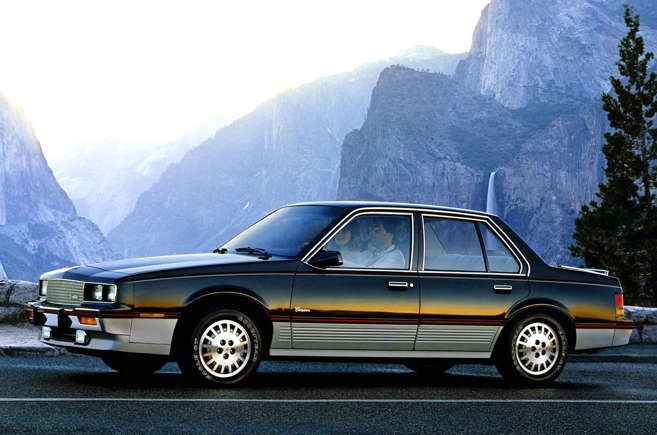1 Cadillac Cimarron (1982) – 2 MODELS

In the early 1980s, General Motors (GM) noticed that BMW and Mercedes were gaining ground in the compact luxury car segment. In response, GM attempted to enter the market by rebadging the Chevrolet Cavalier as a Cadillac, launching the Cimarron. However, the move backfired. The Cimarron’s steep price tag, paired with its underwhelming four-cylinder engine, drew heavy criticism and mockery. Even after GM introduced a V6 engine in 1985, the model failed to shake its poor reputation or boost sales. The Cimarron remains one of the most infamous examples of misguided badge engineering in automotive history.
2 Ford F-150 (2002) – 2 MODELS
In 2002, Ford aimed to elevate its best-selling F-150 truck by introducing a luxury variant under its Lincoln brand, called the Blackwood. Given the F-150’s immense popularity, the move seemed destined for success. However, the reality was quite different. The Lincoln Blackwood failed to resonate with buyers, offering limited utility and a high price that didn’t match its features. As a result, the model was discontinued after just one year, with only a little over 3,000 units produced. The Blackwood has since become a cautionary tale of how branding alone isn’t enough to guarantee success in the automotive market.
3 Rolls-Royce Silver Shadow (1965) – 2 MODELS
Following Rolls-Royce’s acquisition of Bentley Motors in 1931, the two marques began sharing much of their model line-ups, although some retained unique characteristics. However, in the case of the Silver Shadow and its counterpart, the Bentley T-Series, the differences were minimal. Visually and mechanically similar, the two cars were practically interchangeable. As a result, most buyers gravitated toward the more prestigious Rolls-Royce badge. This brand perception led to a stark sales imbalance—while around 30,000 Silver Shadows were sold, only 2,280 four-door Bentley T-Series models found buyers, highlighting the powerful influence of brand image over nearly identical products.
4 Toyota IQ (2011) – 2 MODELS
When Aston Martin aimed to reduce the average CO2 emissions of its lineup, it chose to rebadge the Toyota IQ as the Cygnet. Although the Cygnet featured some exterior tweaks, a redesigned interior, and came with a premium price, the strategy did not meet expectations. Aston Martin significantly overestimated demand, producing only 786 units before ending production in under three years. The company had initially forecasted sales of around 2,000 cars annually, making the Cygnet a rare example of a luxury brand’s unsuccessful attempt to enter the compact city car market.
5 Triumph Acclaim (1981) – 2 MODELS
In 1979, British Leyland partnered with Honda to develop new models together. At the time, the Triumph Dolomite was becoming outdated, so British Leyland rebadged the Honda Ballade and marketed it as the Triumph Acclaim. Aside from the badges, the Acclaim contained no Triumph components. Interestingly, it turned out to be the most reliable vehicle the company had ever offered. However, driving one to a Triumph heritage event might raise some eyebrows, as purists might question its true connection to the brand’s legacy.
6 Land Rover Discovery (1993) – 2 MODELS
In the early 1990s, Honda recognized the need to add a 4×4 vehicle to its lineup. To fill this gap quickly, it licensed the original Land Rover Discovery and sold it as the Crossroad in markets like Japan and New Zealand. Notably, this model featured Honda’s only production V8 engine to date. Later, in 2007, Honda revived the Crossroad name with a completely redesigned version developed entirely in-house, marking a new chapter for the brand’s entry into the SUV segment.
7 Lancia Delta (2011) – 2 MODELS
After Fiat merged with Chrysler, the company demonstrated a bold approach to brand usage. Initially, the Lancia Delta and Lancia Ypsilon were rebadged as Chryslers for the UK market, but they were priced far too high for their appeal. Later, Fiat reversed the strategy by rebranding the Chrysler 200 and Grand Voyager as Lancias, with the Chrysler 200 being sold under the Flavia name. These moves highlighted the sometimes confusing and ambitious efforts to leverage established brand names, often leaving consumers uncertain about the true identity of the vehicles.
8 Saab 9-2X (2005) – 2 MODELS
In 2005, Saab introduced an estate car that many considered a misstep: the Saab 9-2X. Essentially a rebadged Subaru Impreza, this model was the result of General Motors’ ownership of Saab combined with its stake in Fuji Heavy Industries, Subaru’s parent company. Produced for only two model years, the 9-2X saw a limited run of roughly 10,000 units. Despite its shared roots, the car never quite fit Saab’s traditional image, making it a unique but short-lived chapter in the brand’s history.
9 Opel Omega (1996) – 3 MODELS
It was no surprise that General Motors Europe sold the same vehicle under both Opel and Vauxhall badges, but it was more unexpected that this model would be shipped across the Atlantic and rebranded as a Cadillac. GM’s goal was straightforward: create a spacious, comfortable entry-level car to compete with German luxury imports. The logic seemed sound—a German-built GM car could fill this niche. However, the Cadillac Catera struggled to attract buyers. Fortunately, GM chose not to rebadge the model under other American brands like Buick or Oldsmobile, avoiding further dilution of the car’s identity.
10 Mini (1961) – 3 MODELS
BMC didn’t always overuse badge engineering; sometimes it was more selective. The upscale Riley Elf is a good example—it was marketed under just two brands: as the Elf for Riley and the Hornet for Wolseley. This restrained approach allowed BMC to maintain clearer brand identities for these models rather than spreading them too thin across multiple badges.